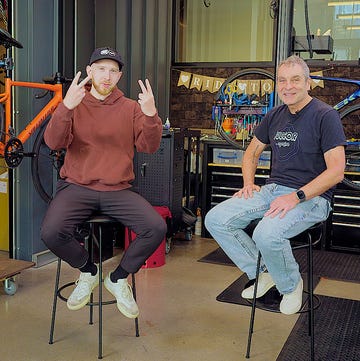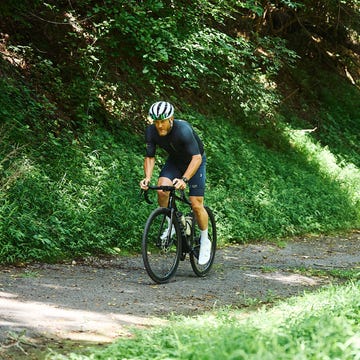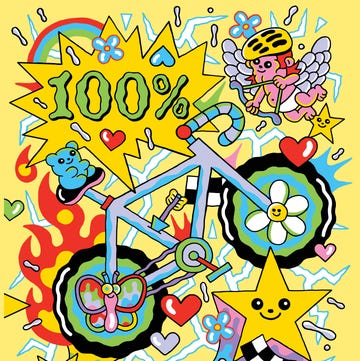Electronic shifting works incredibly well and has become the standard for performance-oriented road, gravel, and mountain bikes. However, riders’ demand for electronic shifting also contributes to the unprecedented prices of top-range bikes.
Since Shimano launched its ten-speed Dura-Ace Di2 groupset in 2009, riders anticipated and expected the trickle-down of technology to other groups. 15 years later, Shimano’s 105 Di2 and SRAM’s Rival AXS are the lowest-priced groups featuring each brand’s electronic shifting technologies. While both options cost thousands less than Dura-Ace and Red, neither is particularly cheap.
Instead of playing the trickle-down long game, WheelTop entered the groupset market with its EDS-TX group priced below Rival AXS and 105 Di2. WheelTop also included clever features you won’t currently find on any groupset from SRAM, Shimano, or even the venerable Campagnolo. But more importantly, for some riders, it’s also available in a rim brake version.
Cut to the Chase: How Much Does it Cost?
Before I answer the all-important price question, it’s important to note that EDS-TX isn’t sold as a complete groupset. Instead, WheelTop packages it as a drivetrain upgrade kit that includes the shifters, disc brake calipers, hydraulic hoses, and derailleurs. Riders can use whatever crankset, chain, and cassette they want. I used a SRAM Red 52/39-tooth crankset, 10-36T Force cassette, and Flattop chain for testing the groupset.
According to Wheeltop, the rear derailleur accepts a 10 or 11-tooth small cog and up to a 36-tooth large cog. The front derailleur is rated for a maximum of a 16-tooth jump between chainrings, which should handle the majority of road gearing setups.
MSRP for the disc brake variant of EDS-TX is $880. But it is currently on sale for $720, and I’ve seen it on various places on the internet for even cheaper than that. The rim brake version of EDS-TX costs even less ($800) and is on sale for $600, as it omits the brakes from the kit. But again, if you look around various marketplace sites online, you can find it for a few hundred dollars less.
For comparison’s sake, I priced out equivalent kits for Shimano’s 105 Di2 and SRAM’s Rival AXS on Competetive Cyclist. Riders should expect to pay $1,243 for the same 105 Di2 parts kit. At $1,015, Rival AXS is more price-competitive than 105 Di2 but costs much more than the market prices for EDS-TX.
For the weight weenie reading, I weighed all three of these “kits” and was surprised to find that SRAM’s Rival AXS was the lightest, with an actual weight for my parts of 1,294 grams. Shimano’s 105 Di2 was heaviest at 1,323 grams and Wheeltop wasn’t far behind SRAM in second at 1,304 grams.
The Joys of Compatability
If you’re wondering if the EDS-TX upgrade kit will be compatible with your bike, the answer is most likely yes.
Wheeltop did something with EDS-TX that other brands seem unwilling or unable to accomplish: make it backward and forward-compatible. When setting up the groupset on a new bike, WheelTop’s app asks you to select the number of gears in your cassette. The options range from three to 14-speed. Each gear slot can be individually fine-tuned to overcome spacing variances between brands and eras. It’s so brilliant and simple that it makes me genuinely mad that no one else has done it yet.
Want to be the first of your friends on a 2x13 groupset? You can purchase a 13-speed Rotor cassette and, with a few clicks in the app, have a 26-speed groupset. Granted, that cassette alone will set you back nearly $500. But the point is, when 13 or even 14-speed cassettes enter the mainstream on the road, you can select that option in the app and be good to go—and theoretically, not need to purchase an entirely new drivetrain.
So, if you’re curious about electronic shifting but don’t want to give up your vintage ride running a similarly vintage drivetrain, you could grab the rim brake version of EDS-TX. With a few clicks in the app, you have a 2 x 8 (or whatever you want it to be) electronic drivetrain.
Shifting Performance
As exciting as broad compatibility is, it would be worth nothing if the group didn’t work. Fortunately, I'm happy to report that the shift of EDS-TX is rock solid. The front and rear derailleurs have yet to let me down, and their reliability and smoothness are right up there with the mainstream brands. However, this level of performance comes with a slightly longer initial setup process. With SRAM, Shimano, and Campy, because the drivetrain speeds are set, the setup is essentially some combination of running a few setup procedures and checking the limits.
With EDS-TX, the process is more involved. I adjusted all 12 cassette positions to get things working as I wanted them to. Granted, I’ll happily take the one-time inconvenience of a longer setup process if it means reliable shifting.
The rear derailleur's shifting speeds are good. It’s not quite as fast as the rear derailleurs from the three major brands, but the difference was small enough that it never bothered me. The front derailleur, on the other hand, is quite slow compared to SRAM AXS or Shimano Di2. It’s roughly on par with Campagnolo’s Super Record Wireless. The saving grace of EDS-TX is just how reliable it is. It never missed a shift, regardless of how much power I put into the pedals.
The front derailleur also has an auto trim function, which means there are never any annoying rubbing noises when you are on the extreme ends of the cassette.
If I were to split hairs, I would say the shifting isn’t quite as good as Rival AXS or 105 Di2. Both groups have speed and precision that EDS-TX doesn’t quite reach. But that performance gap is small enough that I would happily ride EDS-TX on one of my bikes, especially given its price.
Braking Performance
Visually, the EDS-TX brakes look simple and industrial. The design prioritizes function over form and this feels accurate once you use it and work on the parts. WheelTop adhered to common standards for these brakes, which should please riders and mechanics. The brakes use the same pads as Shimano road calipers and one of the first things I did was throw in a set of LO5A pads, which fit perfectly.
The brakes use mineral oil and come with a brass threaded adapter for bleeding. The brakes arrived pre-bled and were no more difficult to set up than any Shimano hydraulic brake I have worked on.
The WheelTop brakes are adequate in terms of on-the-road performance. They have good stopping power and so-so modulation. The feel of the lever is best described as a Shimano hydraulic brake from a few generations ago. The levers do have reach adjustment, though, which is nice. Again, Rival AXS and 105 Di2 have an edge here, but that edge feels very minor—especially when comparing EDS-TX to something other than the latest top-of-the-line brakes from the major brands.
What Can Be Better and What is Missing?
While I’m generally happy with EDS-TX's overall performance, a few small things could be improved or added to the groupset in future iterations. The biggest thing missing for me in everyday use is a lack of secondary shift or accessory buttons on the shifters. There is also no option to add satellite shifters buttons to the groupset.
By modern standards, the levers themselves are relatively small. This could be good for riders with smaller hands or those who prefer smaller hood shapes of past groups. These hoods were never quite as comfortable as I wanted because I’ve grown accustomed to the longer and roomier modern hoods from SRAM, Shimano, and Campagnolo.
My biggest gripe about the hoods was the rubber covers—they use a hard and stiff rubber compound. I cannot see removing the hoods without cutting them off the levers. The rubber makes them difficult to pry up to adjust or install the levers. Worst of all, they have poor grip and comfort.
This might feel minor, but it’s important to point out, considering the hoods are the primary touch point for a rider's hands. Hopefully, Wheeltop will address this issue by adjusting the rubber compound in future batches of hoods and making it available to riders who already own the parts.
I’m also not a huge fan of permanently integrating the batteries into the front and rear derailleur. I suspect this solution was used to skirt existing patents from SRAM and Shimano, but it’s also the worst of both systems and has no real advantages. While I can live with it from a day-to-day perspective, it also raises longevity concerns for the groupset, as it’s impossible to replace a faulty or dead battery without replacing a whole derailleur.
This brings me to my primary concern about the Wheeltop groupset: long-term reliability.
Shimano, SRAM, and Campagnolo have produced electronic groups for over a decade, and I still see those original products being ridden today. It’s also true that the lifespan of electronic motors and gears is not infinite. Still, I can comfortably say that an electronic groupset from the mainstream brands will reasonably have a service life of ten years or so. Wheeltop, on the other hand, is too new to have that kind of long-term broad use to give me the same level of confidence.
This is partially backed up by reports of EDS-TX having issues with various bolts forming surface rust on them after a relatively short time. It's probably not a significant issue (bolts appear standard enough and can easily be replaced with higher-quality hardware). Still, it speaks to the compromises made to hit a low price.
Adding to this, the parts feel and look cheap. It’s hard to quantify this precisely or even capture it in photos. Part of it is the tough plastic of the hoods, but it’s also the feeling you get when you hold the parts in your hands. There’s nothing that will immediately jump out at you when you do this, but as soon as you pick up the same part from one of the “big three,” you notice a difference. There’s precision and solidness from the other brands’ parts that EDS-TX doesn’t quite have.
Conclusions and Final Thoughts
EDS-TX is the most cost-effective way to upgrade your bike to electronic shifting, especially if you currently own a bicycle with a crankset, cassette, and chain in good working order. If that bike uses rim brakes, EDS-TX is more or less your only easy-to-get option. And if your bike has fewer than ten gears at the cassette, it’s the only game in town.
However, what interests me more about EDS-TX are the features that allow riders to select the number of shifts the rear derailleur makes and refine individual shift spacing in minute detail through the app. I have wondered why these features weren’t available from mainstream component brands for years.
For instance, why couldn’t a ten-speed Di2 group work with an 11—or 12-speed cassette of the same gear range through updated firmware? Alternatively, why not allow it to shift nine gears instead of ten?
I have heard various arguments against allowing such broad user control, and most of them boil down to the fact that, at some point, the performance will degrade past manufacturer tolerances, which is a fair point to make. But there is more cross-compatibility and user selectability that modern electronic drivetrains could have than zero. Wheeltop shows that modern electronic groups can be both forward and backward-compatible, at least regarding how many gears the derailleur moves. Hopefully, this pushes the more prominent brands to provide riders with more functionally open products with broader compatibility.
After all, how many gears there are in a groupset is just one factor in the “is this worth hanging on your bike question.” The latest Shimano Dura-Ace is better than its 11-speed version, not because of the extra cog in the back but due to the improved brakes, ergonomics, serviceability, and ease of setup.
From a purely cynical perspective, it’s easy to guess why brands would want to force riders to buy the larger groupset instead of allowing riders to purchase the parts they want and create various amalgamations of groups that suit their bikes and budget. Kudos to SRAM for at least making their latest Red groupset fully backward compatible with all previous 12-speed AXS groups.
However, there is still a long and potentially insurmountable distance between where we are now and my envisioned cross-compatibility utopia. Wheeltop’s EDS-TX groupset has cracked the door in a way that makes the question of why such features aren’t available to riders of other groupsets almost impossible to ignore.
I would be remiss not to mention that WheelTop recently purchased a majority stake in Rotor. This move likely points to WheelTop’s larger plans to play at the higher end of the component market. I also expect WheelTop to offer a complete groupset with cranks, chainrings, and cassettes, as these are all parts Rotor already makes to very high standards.
As for the actual EDS-TX parts that I have been testing? I plan on keeping them on my bike for the foreseeable future. I want to get enough miles on them to answer the long-term durability questions more definitively. Wheeltop’s group offers a compelling value and feature set that isn’t available from the big three component makers.
Notes from the Field
- The proprietary charging cables for the derailleurs attach magnetically, but either the magnets aren’t strong enough, or the angle of the charging ports is so extreme that the attachment is very finicky. This makes it very likely that if you plug your bike in to charge and bump it even slightly, you’ll interrupt the charging process. Fortunately, the cables are interchangeable and Wheeltop gives you two of them.
- I am pleasantly surprised by the shifting button layout on EDS-TX. The single large shift button on the left-hand shifter, which shifts the front derailleur to the chainring it’s currently not in, is simple and brilliant. The buttons for the rear derailleur are both large and distinct and very easy to differentiate, even with gloves on. However, the feedback from these buttons is lacking when shifting. I want a much more distinct click.
- The app could be more straightforward to navigate and better English translations are needed for various functions. Still, it’s hard to argue with how many things about the groupset you can customize and tune. You can even adjust the front derailleur's auto trim function if you aren’t happy with its position through the gear range.
- A cool thing about the app—it displays the number of shifts each derailleur can perform on its current charge level. For example, at 90% charged, the rear derailleur told me it could do 17,640 more shifts, while the front derailleur reported 9,000 remaining shifts at 100% charge.
Test Editor Dan Chabanov got his start in cycling as a New York City bike messenger but quickly found his way into road and cyclocross racing, competing in professional cyclocross races from 2009 to 2019 and winning a Master’s National Championship title in 2018. Prior to joining Bicycling in 2021, Dan worked as part of the race organization for the Red Hook Crit, as a coach with EnduranceWERX, as well as a freelance writer and photographer.


























